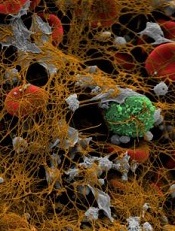
Image by Andre E.X. Brown
The factor Xa inhibitor fondaparinux may confer a lower risk of death and bleeding after heart attack than low-molecular-weight heparin (LMWH).
In a large study, patients who received fondaparinux after non-ST-segment elevation myocardial infarction (NSTEMI) had a lower risk of major bleeding and death, both in the hospital and after discharge, compared to patients who received LMWH.
However, both arms had similar rates of subsequent heart attack or stroke.
Karolina Szummer, MD, PhD, of the Karolinska Institutet in Stockholm, Sweden, and her colleagues disclosed these results in JAMA.
The researchers analyzed data from a Swedish registry that included 40,616 patients with NSTEMI. The patients received in-hospital treatment with fondaparinux (n=14,791; 36.4%) or LMWH (25,825; 63.6%) between September 2006 and June 2010, with follow-up through December 2010.
Patients in the fondaparinux arm were, on average, 2 years younger (72 years vs 74 years) than patients in the LMWH arm. Fondaparinux-treated patients also had fewer previous heart attacks (28.2% vs 32.2%), and fewer had been diagnosed with congestive heart failure (14.5% vs 18.7%), but more had undergone percutaneous coronary intervention (46.4% vs 38.9%).
The rate of prior bleeding events and previous hemorrhagic stroke was similar between the arms. Prior bleeding was reported in 6.1% of patients in both arms, and hemorrhagic stroke was reported in 1.4% of patients in the fondaparinux arm and 1.3% in the LMWH arm.
Following treatment, the absolute rate of severe in-hospital bleeding events was lower in the fondaparinux arm than in the LMWH arm—1.1% vs 1.8% (odds ratio [OR]=0.54).
The rate of severe bleeding while in the hospital or causing readmission was lower in the fondaparinux arm, both at 30 days—1.4% vs 2.1% (OR=0.56)—and at 180 days—1.9% vs 2.8% (OR=0.60).
In-hospital mortality was lower in the fondaparinux arm than the LMWH arm—2.7% and 4.0%, respectively (OR=0.75). The same pattern was observed for mortality at 30 days (OR=0.82) and 180 days (OR=0.76).
However, the rate of recurrent heart attack was similar in both arms. At 30 days, it was 9.0% in the fondaparinux arm and 9.5% in the LMWH arm (OR=0.94). And at 180 days, rates were 14.2% and 15.8%, respectively (OR=0.97).
Likewise, the rate of stroke did not differ significantly between the arms. At 30 days, it was 0.5% in the fondaparinux arm and 0.6% in the LMWH arm (OR=1.11). And at 180 days, rates were 1.7% and 2.0%, respectively (OR=0.98).
The results were similar in patients with varying degrees of kidney function and in the subset of patients who had undergone early percutaneous coronary intervention.
The researchers said these results provide an estimate of the treatment effect in a selected patient population. However, the effects may differ in clinical practice and should therefore be investigated in observational cohorts and in continuous registries.


